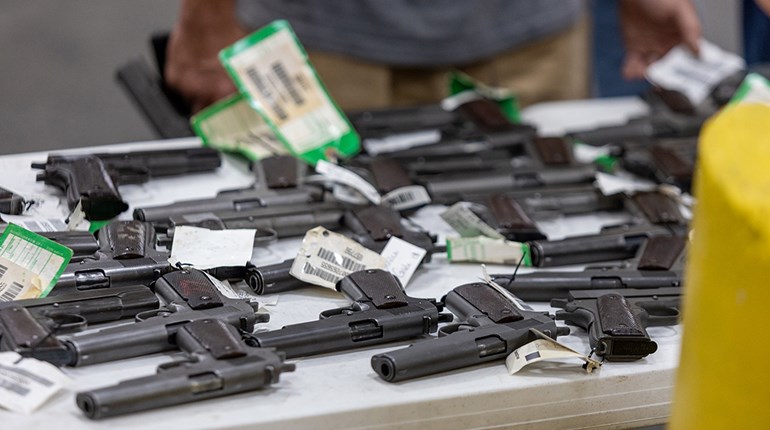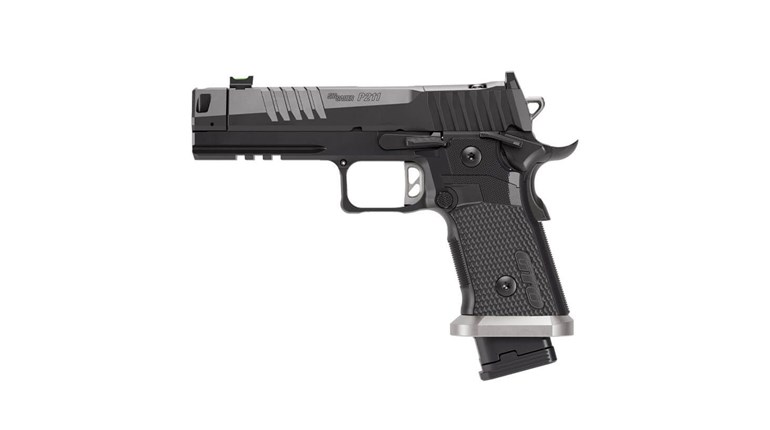** When you buy products through the links on our site, we may earn a commission that supports NRA's mission to protect, preserve and defend the Second Amendment. **
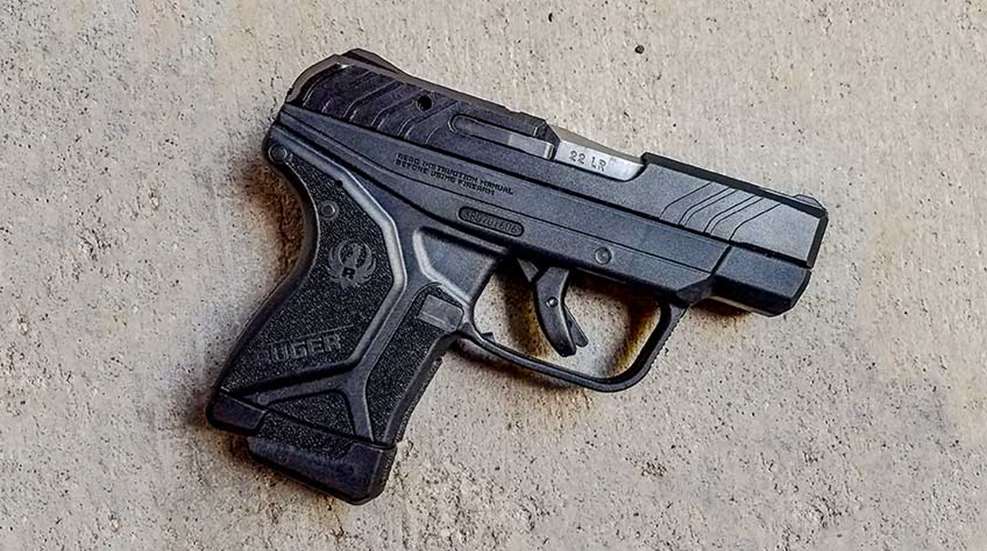
Ruger is one of the most diverse makers of firearms in the United States, with products ranging from rimfire and centerfire rifles for plinking and hunting to handguns for target shooting and self-defense. One gem among these various products is a small, semi-automatic pistol called the LCP. Launched in 2008, it was an immediate hit with the concealed carry crowd and has become a standard in its market.
As good as the LCP is, the original design wasn't perfect. The LCP's sights are really nothing more than tiny bumps machined directly into the slide. They work to get the handgun pointed in the right direction but seem more of an afterthought than a design feature. Another common gripe is the trigger. Many users think the trigger is too long and heavy. Not intended to be a target pistol (see complaint about sights above), the trigger is acceptable for concealed carry use but is heavy and long nonetheless.
Ruger heard these complaints and introduced the LCP II in 2016 (reviewed here). It addresses the concerns of sights by adding slightly bigger machined-in bumps. The trigger is improved by switching from a long and heavy double-action-only pull to a lighter and shorter single-action-only pull. Ruger also added a last round hold-open to the pistol to aid in reloading and as an indication that the magazine is empty.
Given Ruger's success with the LCP and LCP II, it was inevitable that either pistol would be made available in something other than .380 ACP. Internet rumors have swirled for quite some time about different calibers. Many people, myself included, were guessing that a version in .32 ACP or possibly .32 NAA was soon to be released. Imagine my surprise when I learned that the first new offering is chambered in none other than .22 LR.
At first glance, the Lite Rack .22 LR version is nearly indistinguishable from the .380 ACP variant. Both pistols share the same overall size and shape. Grip texturing and overall cosmetic patterns like cocking serrations and placement of logos are also nearly identical.
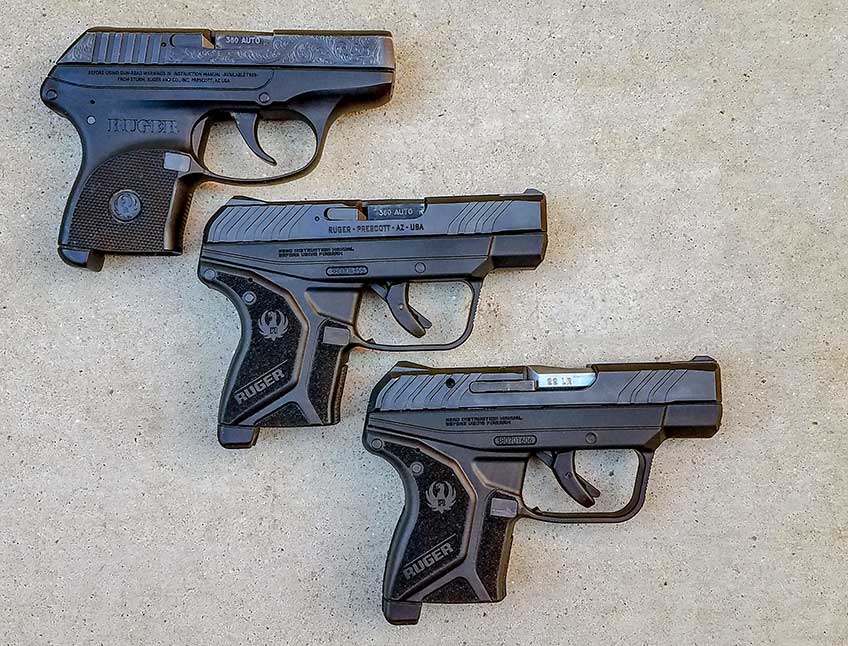
Upon closer inspection, a few notable differences become apparent. The first is the barrel. Constructed from 400-series stainless steel, it is marked ".22 LR" on its right. The barrel appears to lock into the slide and operate on Browning's tilting barrel principle, but the handgun actually operates via blowback. The barrel tilts down as the slide reciprocates but has no locking lug. Ruger says the barrel tilts for two reasons. Firstly it aids in feeding because the chamber actually swings down closer to the magazine. Secondly it keeps the pistol's overall dimensions the same as the .380 ACP model and allows for maximum parts interchangeability between the two firearms.
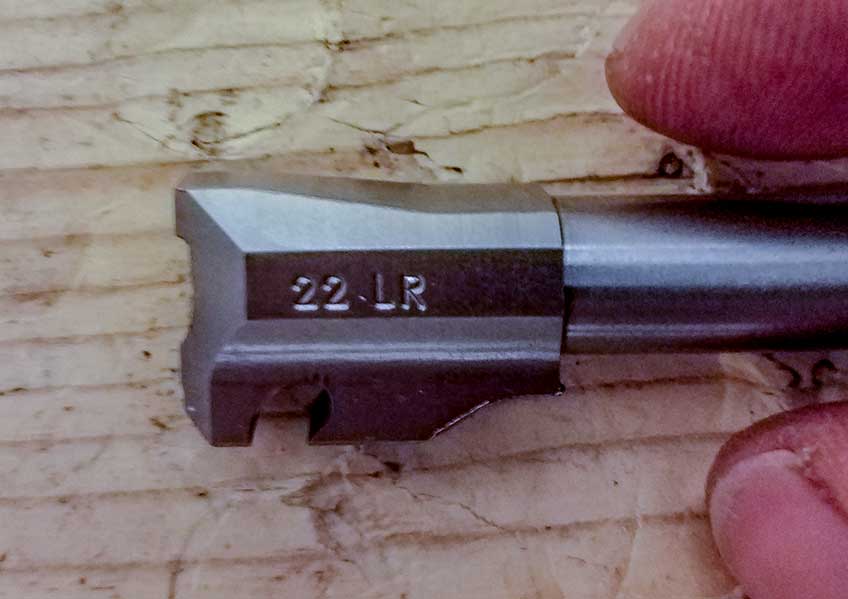
The slide's flared rear cocking serrations provide very slight "ears" at the back of the slide. Similar to what some other companies are doing, these wings allow the shooter to get a slightly better purchase when working the slide to chamber an initial round, clear a malfunction (more on this in a moment) or to unload the pistol. Although providing a bit more surface area to work with, the wings are small enough not to ruin the Ruger Lite Rack LCP II's overall dimensions. These wings would be a nice addition to the .380 ACP model and will hopefully be included in the near future.
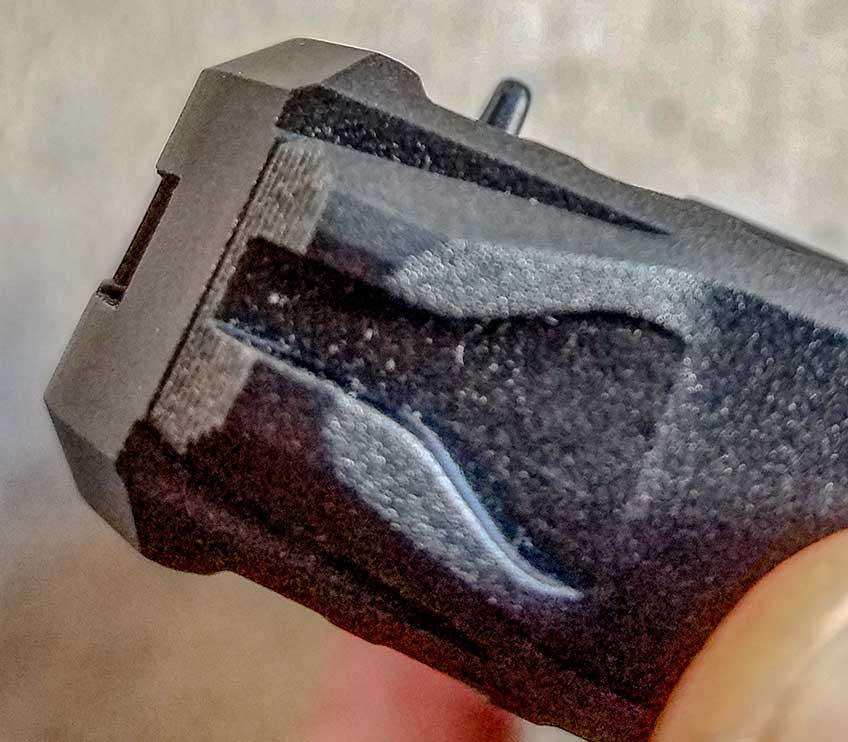
Also added is a thumb safety. It, like the slide wings, is a small and fairly unobtrusive piece that does little to change the pistol's small size. Unlike most other thumb safeties that pivot up and down and travel in an arc, the LCP's safety runs fore and aft. Upon initial handling, I found the safety poorly located and hard to use. After a little practice, I had no real problem pushing the safety off with my right thumb by keeping it more or less straight up and down while gripping the pistol. Similarly, I found the safety can be re-engaged by moving the shooting hand thumb in front of the lever and then swiping the thumb backwards. The safety is not ambidextrous, so left-handed shooters are more or less out of luck. Also new to the Lite Rack LCP II .22’s design is a magazine disconnect that deactivates the trigger if the magazine is removed. This disconnect is not present on the .380 ACP model.
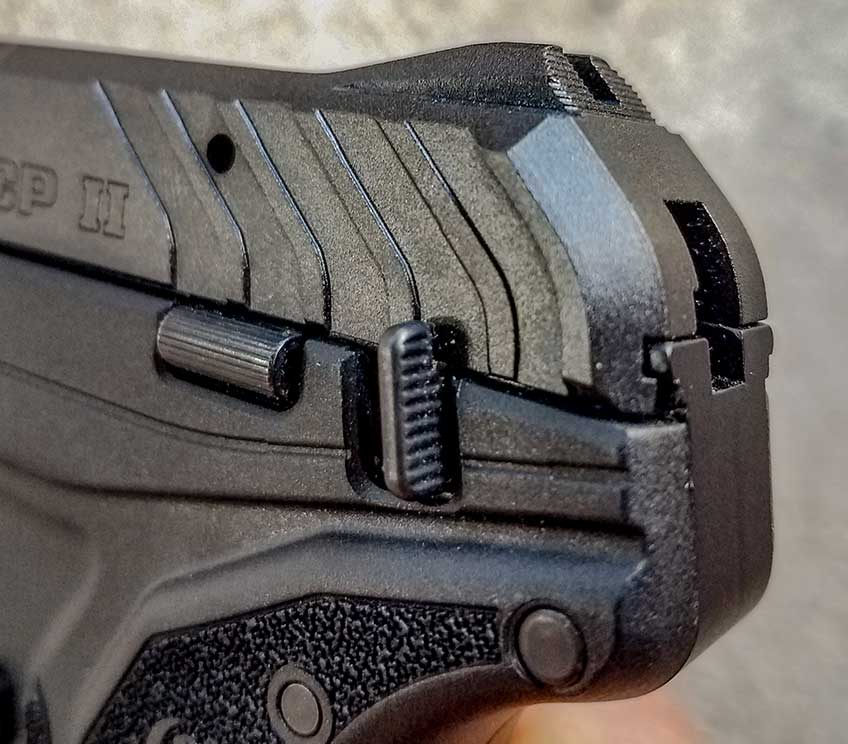
On the topic of safety; the LCP II’s hammer and sear engagement is very robust, but Ruger added a secondary sear that will catch the hammer in case the pistol receives a sufficient shock that might jar the hammer loose. In testing, Ruger engineers found the primary sear engagement was so good they actually had to be machine away part of the sear to test the secondary engagement.
During range testing, I had upwards of 10 percent misfires while using the inexpensive "bulk pack" rimfire ammo from several manufacturers. Fortunately CCI Velocitor and Mini Mag performed without issue through close to 300 rounds fired. Is this a condemnation of the Ruger or a treatise of the current state of inexpensive .22 LR ammo? My advice is is to use .22 LR ammo that comes in 50- and 100-round boxes, unless you're intending to test the slide wings and work on malfunction clearance techniques. Aside from misfires with the cheap stuff, I had no failures to feed, extract or eject with ammo that did fire and had no other issues with the pistol, save the occasional instance of bumping the slide catch, thereby keeping the slide from locking open on the last shot.
There are many important factors that must be considered when choosing a handgun for self-defense. Who will likely use it? Will it be kept in the home or will it be carried in a holster, purse or jacket pocket? What caliber is the right choice for the firearm’s intended user? No firearms expert would likely ever recommend .22 LR for defense. Still, there are no doubt large numbers of .22s in pockets and purses around the country. A Shooting Illustrated article by Richard Mann (linked here) indicates that .22 LR, while far from ideal, may still have some application as a defensive cartridge.
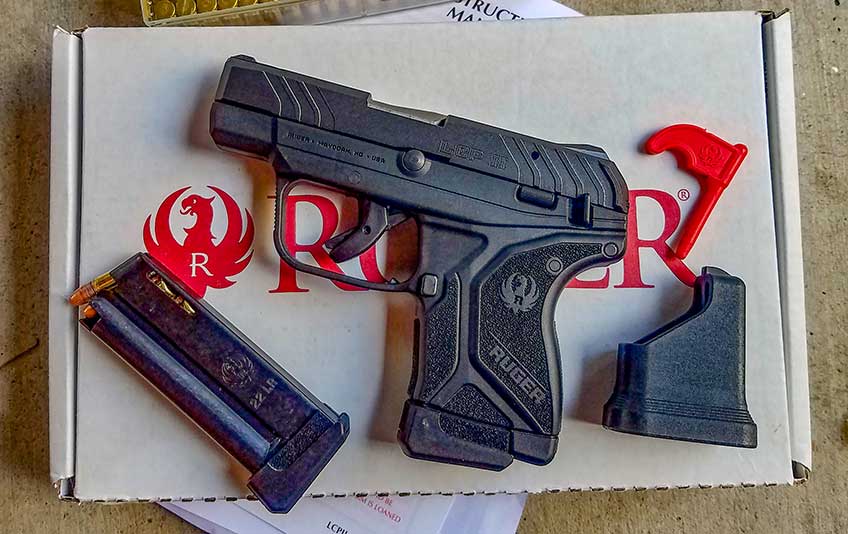
However, Ruger isn’t marketing the Lite Rack LCP II .22 as a defensive handgun, so why choose to make it in .22 LR when something else would seem more practical? The simple answer is customer demand. A .22-caliber LCP had been one of Ruger’s most-heard requests since the original pistol was introduced more than a decade ago. Cheap to shoot and easy to control, the new .22 LR version should make a great trainer to anyone who owns the .380 ACP model.
Going through 50 or 100 rounds of .380 ACP in one of these little guns can be a chore. Practicing with the .22 LR LCP II certainly makes things easier on the shooter, and the round has long been used in other guns as an introductory cartridge as well as for low-budget practice. Besides, not every firearm needs to have a defensive application. Sometimes they can be fun to shoot and enjoy simply for what they are. That may just be the best reason to buy the new Ruger LCP II .22 LR.
Ruger Lite Rack LCP II .22 LR Specifications
Model Number: 13705
Caliber: .22 Long Rifle
Barrel: 2.75 inches, 1:16-inch twist rate
Overall length: 5.20 inches
Width: .81 inch
Weight: 11.2 ounces
Magazine capacity: 10 rounds
MSRP: $349
As good as the LCP is, the original design wasn't perfect. The LCP's sights are really nothing more than tiny bumps machined directly into the slide. They work to get the handgun pointed in the right direction but seem more of an afterthought than a design feature. Another common gripe is the trigger. Many users think the trigger is too long and heavy. Not intended to be a target pistol (see complaint about sights above), the trigger is acceptable for concealed carry use but is heavy and long nonetheless.
Ruger heard these complaints and introduced the LCP II in 2016 (reviewed here). It addresses the concerns of sights by adding slightly bigger machined-in bumps. The trigger is improved by switching from a long and heavy double-action-only pull to a lighter and shorter single-action-only pull. Ruger also added a last round hold-open to the pistol to aid in reloading and as an indication that the magazine is empty.
Given Ruger's success with the LCP and LCP II, it was inevitable that either pistol would be made available in something other than .380 ACP. Internet rumors have swirled for quite some time about different calibers. Many people, myself included, were guessing that a version in .32 ACP or possibly .32 NAA was soon to be released. Imagine my surprise when I learned that the first new offering is chambered in none other than .22 LR.
At first glance, the Lite Rack .22 LR version is nearly indistinguishable from the .380 ACP variant. Both pistols share the same overall size and shape. Grip texturing and overall cosmetic patterns like cocking serrations and placement of logos are also nearly identical.

Upon closer inspection, a few notable differences become apparent. The first is the barrel. Constructed from 400-series stainless steel, it is marked ".22 LR" on its right. The barrel appears to lock into the slide and operate on Browning's tilting barrel principle, but the handgun actually operates via blowback. The barrel tilts down as the slide reciprocates but has no locking lug. Ruger says the barrel tilts for two reasons. Firstly it aids in feeding because the chamber actually swings down closer to the magazine. Secondly it keeps the pistol's overall dimensions the same as the .380 ACP model and allows for maximum parts interchangeability between the two firearms.

The slide's flared rear cocking serrations provide very slight "ears" at the back of the slide. Similar to what some other companies are doing, these wings allow the shooter to get a slightly better purchase when working the slide to chamber an initial round, clear a malfunction (more on this in a moment) or to unload the pistol. Although providing a bit more surface area to work with, the wings are small enough not to ruin the Ruger Lite Rack LCP II's overall dimensions. These wings would be a nice addition to the .380 ACP model and will hopefully be included in the near future.

Also added is a thumb safety. It, like the slide wings, is a small and fairly unobtrusive piece that does little to change the pistol's small size. Unlike most other thumb safeties that pivot up and down and travel in an arc, the LCP's safety runs fore and aft. Upon initial handling, I found the safety poorly located and hard to use. After a little practice, I had no real problem pushing the safety off with my right thumb by keeping it more or less straight up and down while gripping the pistol. Similarly, I found the safety can be re-engaged by moving the shooting hand thumb in front of the lever and then swiping the thumb backwards. The safety is not ambidextrous, so left-handed shooters are more or less out of luck. Also new to the Lite Rack LCP II .22’s design is a magazine disconnect that deactivates the trigger if the magazine is removed. This disconnect is not present on the .380 ACP model.

On the topic of safety; the LCP II’s hammer and sear engagement is very robust, but Ruger added a secondary sear that will catch the hammer in case the pistol receives a sufficient shock that might jar the hammer loose. In testing, Ruger engineers found the primary sear engagement was so good they actually had to be machine away part of the sear to test the secondary engagement.
During range testing, I had upwards of 10 percent misfires while using the inexpensive "bulk pack" rimfire ammo from several manufacturers. Fortunately CCI Velocitor and Mini Mag performed without issue through close to 300 rounds fired. Is this a condemnation of the Ruger or a treatise of the current state of inexpensive .22 LR ammo? My advice is is to use .22 LR ammo that comes in 50- and 100-round boxes, unless you're intending to test the slide wings and work on malfunction clearance techniques. Aside from misfires with the cheap stuff, I had no failures to feed, extract or eject with ammo that did fire and had no other issues with the pistol, save the occasional instance of bumping the slide catch, thereby keeping the slide from locking open on the last shot.
There are many important factors that must be considered when choosing a handgun for self-defense. Who will likely use it? Will it be kept in the home or will it be carried in a holster, purse or jacket pocket? What caliber is the right choice for the firearm’s intended user? No firearms expert would likely ever recommend .22 LR for defense. Still, there are no doubt large numbers of .22s in pockets and purses around the country. A Shooting Illustrated article by Richard Mann (linked here) indicates that .22 LR, while far from ideal, may still have some application as a defensive cartridge.

However, Ruger isn’t marketing the Lite Rack LCP II .22 as a defensive handgun, so why choose to make it in .22 LR when something else would seem more practical? The simple answer is customer demand. A .22-caliber LCP had been one of Ruger’s most-heard requests since the original pistol was introduced more than a decade ago. Cheap to shoot and easy to control, the new .22 LR version should make a great trainer to anyone who owns the .380 ACP model.
Going through 50 or 100 rounds of .380 ACP in one of these little guns can be a chore. Practicing with the .22 LR LCP II certainly makes things easier on the shooter, and the round has long been used in other guns as an introductory cartridge as well as for low-budget practice. Besides, not every firearm needs to have a defensive application. Sometimes they can be fun to shoot and enjoy simply for what they are. That may just be the best reason to buy the new Ruger LCP II .22 LR.
Ruger Lite Rack LCP II .22 LR Specifications
Model Number: 13705
Caliber: .22 Long Rifle
Barrel: 2.75 inches, 1:16-inch twist rate
Overall length: 5.20 inches
Width: .81 inch
Weight: 11.2 ounces
Magazine capacity: 10 rounds
MSRP: $349













